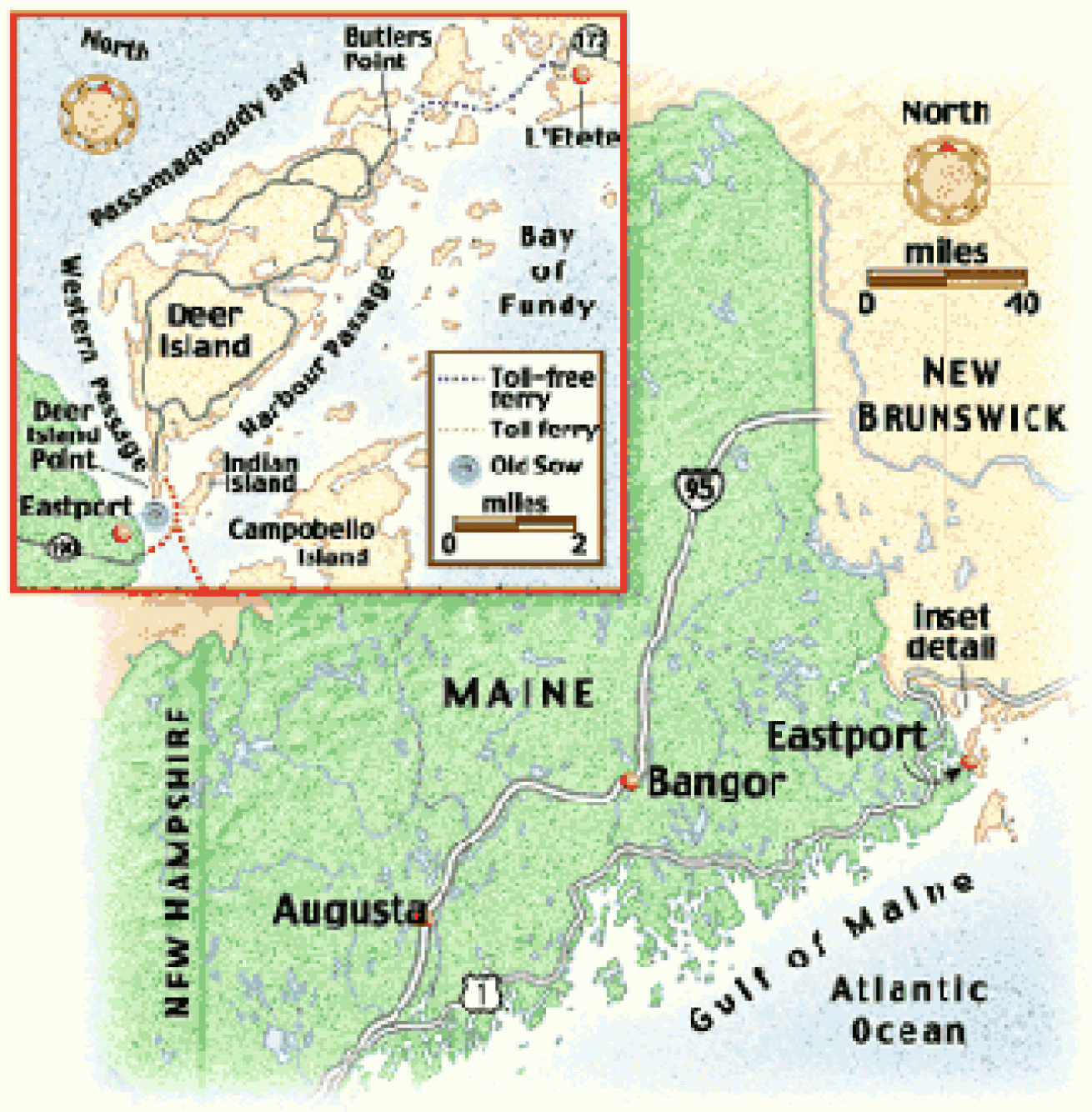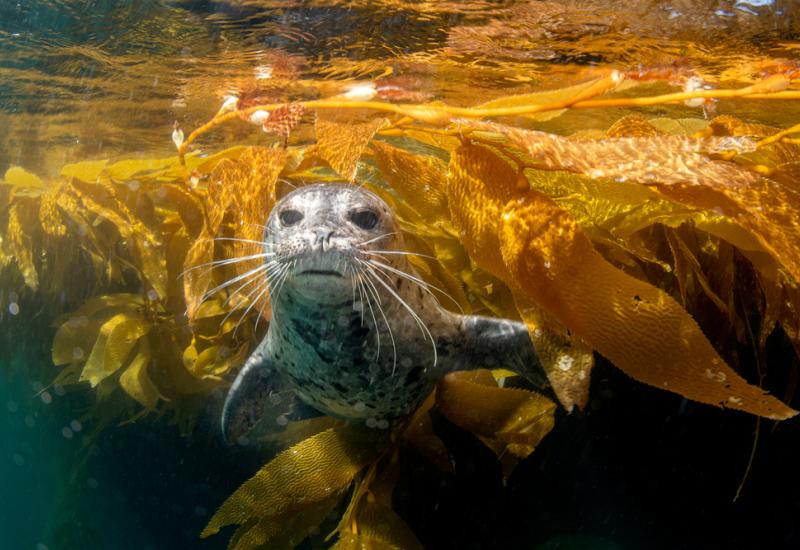New Brunswick: Deer Island

A Montague shrimp enjoys the calm of slack tide at Deer Island Point.
January 2003
Text and Photography by Jerry Shine
My buddy stared down at the whirlpools swirling through the water below.
"Please tell me this isn't the place."
"Sorry," I said, pulling tanks from the trunk of our car. "This is the place."
We had just driven up through Maine, across the Canadian border to the fishing village of L'Etete, where we caught a ferry to Deer Island. From the beach at Deer Island Point, the scenery could not have been more beautiful. Forests of pine grew right up to the water's edge. Stark cliffs of offshore islands rose straight up from the seafloor. A bald eagle soared overhead.
But the water was a different story. It frothed and boiled like river rapids. Driftwood bobbed and spun helplessly. Rips and eddies tore this way and that. And just off the beach, in the middle of it all, the largest tidal whirlpool in the Western Hemisphere--nicknamed "Old Sow"--spun round and round like some great Hollywood special effect.
"You're absolutely, positively certain this is the place?" she asked again.
"This is the place," I laughed. I was not, however, unsympathetic. The Bay of Fundy can be a disconcerting place for divers. Twice a day, every day, the largest tides in the world (50-plus feet) roar in and out, setting billions of gallons of water in motion. Here at Deer Island, situated near the mouth of the bay, they average 20 feet.
The key, obviously, is to go in only at slack water--the lull between tides. Sure enough, as we geared up, the flooding tide peaked and soon the bay fell calm. We dived down along a sloping ledge covered with urchins, then rounded the wall's corner to come face-to-face with a barrage of color and life. Massive yellow sponges covered the rocks, interspersed with oversized northern red anemones. Sea stars of just about every size, shape and color packed the ledges.
Large lobsters prowled the bottom. Sculpin, sea raven and ocean pout lay atop rock outcroppings, while Montague shrimp and red-gilled nudibranchs staked out spots between them. All the while, a school of pollack circled around us. In short--it was a great dive.
"So what did you think?" I asked my buddy as we broke the surface and headed back to the beach.
"Yeah," she laughed, "I'm pretty sure this is the place."

Dive In: Deer Island

GET THERE: Year-round ferry service to Deer Island is available from L'Etete, New Brunswick. To reach Deer Island Point, follow the main road south to the end of the island. In July and August, ferries from Eastport, Maine, and from Campobello Island land on Deer Point less than a mile from the beach.
WATER CONDITIONS: Visibility rarely exceeds 10 feet. Temperatures range from the low 50Fs in the summer, to the low 30Fs in winter. A dry suit is a must.
DIVE PROFILE: Deer Island Point is a very advanced dive even at slack tide. An average window of calm water is just 15 minutes long, and changing tides can create downwellings along the wall. Consult tide tables and seek local advice before diving here.
DIVE OPERATORS: There are no full-service dive shops on the island, though air fills and tank rentals are available from Dempsey's Dive Supplies, (506) 747-2362, and Fundy Diving Equipment, (506) 755-2233.

A Montague shrimp enjoys the calm of slack tide at Deer Island Point.
January 2003
Text and Photography by Jerry Shine
My buddy stared down at the whirlpools swirling through the water below.
"Please tell me this isn't the place."
"Sorry," I said, pulling tanks from the trunk of our car. "This is the place."
We had just driven up through Maine, across the Canadian border to the fishing village of L'Etete, where we caught a ferry to Deer Island. From the beach at Deer Island Point, the scenery could not have been more beautiful. Forests of pine grew right up to the water's edge. Stark cliffs of offshore islands rose straight up from the seafloor. A bald eagle soared overhead.
But the water was a different story. It frothed and boiled like river rapids. Driftwood bobbed and spun helplessly. Rips and eddies tore this way and that. And just off the beach, in the middle of it all, the largest tidal whirlpool in the Western Hemisphere--nicknamed "Old Sow"--spun round and round like some great Hollywood special effect.
"You're absolutely, positively certain this is the place?" she asked again.
"This is the place," I laughed. I was not, however, unsympathetic. The Bay of Fundy can be a disconcerting place for divers. Twice a day, every day, the largest tides in the world (50-plus feet) roar in and out, setting billions of gallons of water in motion. Here at Deer Island, situated near the mouth of the bay, they average 20 feet.
The key, obviously, is to go in only at slack water--the lull between tides. Sure enough, as we geared up, the flooding tide peaked and soon the bay fell calm. We dived down along a sloping ledge covered with urchins, then rounded the wall's corner to come face-to-face with a barrage of color and life. Massive yellow sponges covered the rocks, interspersed with oversized northern red anemones. Sea stars of just about every size, shape and color packed the ledges.
Large lobsters prowled the bottom. Sculpin, sea raven and ocean pout lay atop rock outcroppings, while Montague shrimp and red-gilled nudibranchs staked out spots between them. All the while, a school of pollack circled around us. In short--it was a great dive.
"So what did you think?" I asked my buddy as we broke the surface and headed back to the beach.
"Yeah," she laughed, "I'm pretty sure this is the place."

Dive In: Deer Island

GET THERE: Year-round ferry service to Deer Island is available from L'Etete, New Brunswick. To reach Deer Island Point, follow the main road south to the end of the island. In July and August, ferries from Eastport, Maine, and from Campobello Island land on Deer Point less than a mile from the beach.
WATER CONDITIONS: Visibility rarely exceeds 10 feet. Temperatures range from the low 50Fs in the summer, to the low 30Fs in winter. A dry suit is a must.
DIVE PROFILE: Deer Island Point is a very advanced dive even at slack tide. An average window of calm water is just 15 minutes long, and changing tides can create downwellings along the wall. Consult tide tables and seek local advice before diving here.
DIVE OPERATORS: There are no full-service dive shops on the island, though air fills and tank rentals are available from Dempsey's Dive Supplies, (506) 747-2362, and Fundy Diving Equipment, (506) 755-2233.










